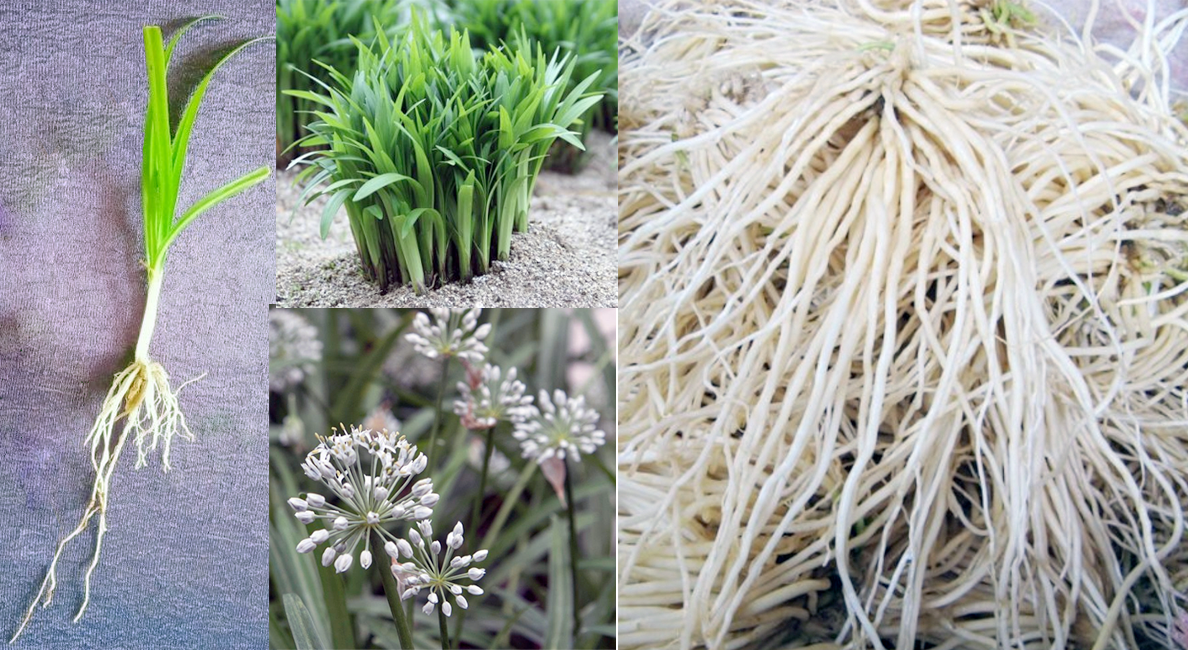 Hooker Chives,
Allium
hookeri. Whole
plant, dug up
(left), stand of
cultivated plants,
(centre top) plants
in flower (centre
bottom) and edible
fleshy roots
(right)..
Hooker Chives,
Allium
hookeri. Whole
plant, dug up
(left), stand of
cultivated plants,
(centre top) plants
in flower (centre
bottom) and edible
fleshy roots
(right)..
Welcome to the summary page for FabulousFusionFood's Herb guide to Hooker Chives along with all the Hooker Chives containing recipes presented on this site, with 2 recipes in total.
e This is a continuation of an entire series of pages that will, I hope, allow my visitors to better navigate this site. As well as displaying recipes by name, country and region of origin I am now planning a whole series of pages where recipes can be located by meal type and main ingredient. This page gives a listing of all the Cornish recipes added to this site.
These recipes, all contain Hooker Chives as a major herb flavouring.
Allium hookeri or Hooker Chives also known as: Hooker's Onion and Garlic Chives is a bulbous perennial herb in the Allium (onion) family with thick, fleshy roots. Bulbs are clustered and cylindrical. Leaves are linear, shorter than or almost equalling the flowering scape, 0.5-1 cm wide, midvein distinct. Scape usually arises from base of bulb, 20-60 cm tall, usually without leaf sheaths, sometimes with 1. Flowers are borne in hemispheric to spherical, many flowered umbels. Flower-stalks are nearly equal, 2-3 time as long as the petals. Tepals are white or greenish yellow to yellow, lance-shaped, 4-7.5 × 1-1.5 mm, tip long-pointed, sometimes unequally 2-lobed. Filaments are very narrow, tapering above, slightly shorter than or equaling the tepals, fused at base and fixed to perianth segments.
It is native to India, Sri Lanka, Myanmar (Burma), Bhutan, and southwestern China (Sichuan, Tibet and Yunnan) but has been extensively cultivated outside its native range, particularly in Asia. The plant is insect repellent and is sometimes cultivated for this purpose.
The bulb, fleshy roots, leaves and flowers are all edible. The flower is used as a garnish for salads. The bulb and roots are particularly valued in Manipuri cuisine. The leaves are eaten raw or cooked as a vegetable. The plant is a popular food in parts of China and southeast Asia, where the leaves are commonly used as a garnish and flavouring. It is gathered from the wild and is also often cultivated as a food crop in southern China and northwest India; it is often found for sale in local markets.
In Manipur, the plant is extensively used to garnish the cooking. It is a fairly common ingredient in pakoras, thongbas (curries), omelettes and an essential ingredient in paaknam.
e This is a continuation of an entire series of pages that will, I hope, allow my visitors to better navigate this site. As well as displaying recipes by name, country and region of origin I am now planning a whole series of pages where recipes can be located by meal type and main ingredient. This page gives a listing of all the Cornish recipes added to this site.
These recipes, all contain Hooker Chives as a major herb flavouring.
Allium hookeri or Hooker Chives also known as: Hooker's Onion and Garlic Chives is a bulbous perennial herb in the Allium (onion) family with thick, fleshy roots. Bulbs are clustered and cylindrical. Leaves are linear, shorter than or almost equalling the flowering scape, 0.5-1 cm wide, midvein distinct. Scape usually arises from base of bulb, 20-60 cm tall, usually without leaf sheaths, sometimes with 1. Flowers are borne in hemispheric to spherical, many flowered umbels. Flower-stalks are nearly equal, 2-3 time as long as the petals. Tepals are white or greenish yellow to yellow, lance-shaped, 4-7.5 × 1-1.5 mm, tip long-pointed, sometimes unequally 2-lobed. Filaments are very narrow, tapering above, slightly shorter than or equaling the tepals, fused at base and fixed to perianth segments.
It is native to India, Sri Lanka, Myanmar (Burma), Bhutan, and southwestern China (Sichuan, Tibet and Yunnan) but has been extensively cultivated outside its native range, particularly in Asia. The plant is insect repellent and is sometimes cultivated for this purpose.
The bulb, fleshy roots, leaves and flowers are all edible. The flower is used as a garnish for salads. The bulb and roots are particularly valued in Manipuri cuisine. The leaves are eaten raw or cooked as a vegetable. The plant is a popular food in parts of China and southeast Asia, where the leaves are commonly used as a garnish and flavouring. It is gathered from the wild and is also often cultivated as a food crop in southern China and northwest India; it is often found for sale in local markets.
In Manipur, the plant is extensively used to garnish the cooking. It is a fairly common ingredient in pakoras, thongbas (curries), omelettes and an essential ingredient in paaknam.
The alphabetical list of all Hooker Chives recipes on this site follows, (limited to 100 recipes per page). There are 2 recipes in total:
Page 1 of 1
| Nga Atoiba Thongba (Manipuri Broken Fish Curry) Origin: India | Sareng Thongba (Manipuri Catfish Curry) Origin: India |
Page 1 of 1